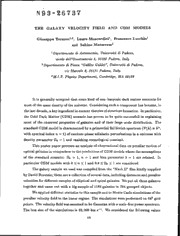
NASA Technical Reports Server (NTRS) 19930017548: The galaxy velocity field and CDM models PDF
Preview NASA Technical Reports Server (NTRS) 19930017548: The galaxy velocity field and CDM models
N 9 3 - 2 6 7 37 THE GALAXY VELOCITY FIELD AND COM MODELS Giuseppe Tormen1'3, Lauro Moscardini1, Francesco Lucchin1 and Sabino Matarrese2 1 Dipartimento di Asironomia, Universitd di Padova, vicolo dell'Oaservatorio 5, 35122 Padova, Italy. 2Dipartimento di Fisica "Galileo Galilei", Univeraitd di Padova, vie. Marzolo 8, 35131 Padova, Italy. 3M.I.T. Physics Department, Cambridge, MA 02139 It is generally accepted that some kind of non-baryonic dark matter accounts for most of the mass density of the universe. Considering such a component has become, in the last decade, a key ingredient in current theories of structure formation. In particular, the Cold Dark Matter (CDM) scenario has proven to be quite successfull in explaining most of the observed properties of galaxies and of their large-scale distribution. The standard CDM model is characterized by a primordial Zel'dovich spectrum ("P(k) oc kn, with spectral index n = 1) of random-phase adiabatic perturbations in a universe with density parameter f&o = 1 and vanishing cosmological constant. This poster paper presents an analysis of observational data on peculiar motion of optical galaxies in comparison to the predictions of CDM models where the assumptions of the standard scenario: fio = 1, n = 1 and bias parameter 6 = 1 are relaxed. In particular CDM models with 0 < n < 1 and 0.4 < fl < 1 are considered. 0 The galaxy sample we used was compiled from the "Mark II" files kindly supplied by David Burstein; these are a collection of several data, including distances and peculiar velocities for different samples of elliptical and spiral galaxies. We put all these galaxies together and came out with a big sample of 1184 galaxies in 704 grouped objects. We applied different statistics to this sample and to Monte Carlo simulations of the peculiar velocity field in the linear regime. The simulations were performed on 643 grid points. The velocity field was assumed to be Gaussian with a scale-free power spectrum. The box size of the simulations is 32,000 km s"1. We considered the following values 66 for the model parameters: S1 = 0.4,1, n = 0,0.5,1 and 6 = 1,1.5,2. 0 We constructed our simulated catalogs of radial peculiar velocities by locating the "observer" in a grid-point with features similar to those of the Local Group, and sampling the velocity field at the same position of the observed galaxies. The observed velocity field is affected by sources of indetermination, mainly dis- tance errors and sampling inhomogeneities. We tried to reproduce these effects on the simulated data, to better compare the real catalog with the mock ones. To take into account galaxy distance errors we perturbed each distance and radial peculiar velocity with Gaussian noise (e.g. Dekel, Bertschinger & Faber 1990, ApJ 364, 349); we then extracted several catalogs from each simulation, by picking up different location of the Local Group, in order to reproduce the sparse sampling of the real data. This result in an overall number of 5,000 catalogs for each model. Our study is carried out in the linear regime, both with rms values and with Monte Carlo simulations, in order to keep into account the different effects of statistical devia- tions from the mean, sparse sampling, distance errors and observational bounds. These effects will actually lead to remarkable differences between the simple rms theoretical prediction and the more realistic Monte Carlo simulations. The first statistics we applied to our data sample is a velocity dipole analysis (bulk flow). The other relevent statistics is the velocity correlation function ^i(r) (Gorsky et al., 1989, ApJ 344, 1). We applied these two statistics also to our simulated catalogs, together with a statistics based on the selection of the observers, i.e. the requirement that the spatial position from which each catalog is "seen" has features similar to those of the Local Group. The effect of these constraints proved to be strong; the statistical results for the models turn out to be quite different from simple unconstrained estimates. As the statistics we used are independent, or almost independent, we could apply a Maximum Likelihood analysis to the theoretical results in the simplest way, £(0) = nil, *«(*)• A discussion about the results of these analysis is presented. 67
